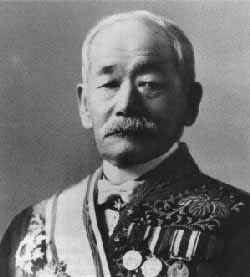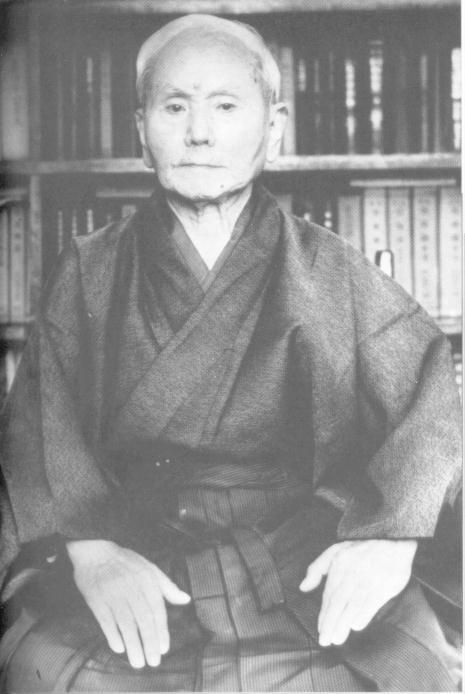|
[Home]
[Judo]
[Karate-do]
[Aikido]
| |
| JUDO:
('The Soft' or 'Gentle Way', 'the Way of Flexibility') Judo is derived from
jujutsu. It was created by Professor Jigoro Kano who was born in Japan on October 28, 1860
and who died May 4, 1938 after a lifetime of promoting judo. Mastering several styles of
jujutsu including kito-ryu and tenjin-shinyo ryu in his youth he began to develop his own
system based on modern sports principles. In 1882 he founded the Kodokan Judo Institute in
Tokyo where he began teaching, and which still is the international authority for judo.
Kano emphasised the larger educational value of training in attack and defense so that it
could be a path or way of life that all people could participate in and benefit from. He
eliminated some of the traditional jujutsu techniques and changed training methods so that
most of the moves could be done with full force to create a decisive victory without
injury. The popularity of judo increased dramatically after a famous contest hosted by the
Tokyo police in 1886 where the judo team defeated the most well-known jujutsu school of
the time. It then became a part of the Japanese physical education system and began its
spread around the world. In 1964 men's judo competition became a part of the Olympics, the
only eastern martial art that is an official medal sport. In 1992 judo competition for
women was added to the Olympics. Judo consists primarily of throws, along with grappling,
which includes pins, chokes, and armbars. Additional techniques, including atemi-waza
(striking) and various joint locks are found in the judo kata. Most instructors
stress the principles of judo such as the principle of yielding to overcome greater
strength or size, as well as the scientific principles of leverage, balance, efficiency,
momentum and control. Seiryoku zenyo (maximum efficiency) and jita kyoei (mutual welfare
and benefit) are best known of the principles of judo. |
 |
| KARATEDO:
('The Way of the Hand that Emenates from the Void') Gichin Funakoshi was born
premature and frail and was given to his maternal grandparents to raise. While attending
primary school he began receiving karate instruction. According to Funakoshi, after he had
trained a couple of years, he realized that his health had improved tremendously and that
he was no longer frail. It was at this time, he began to contemplate making karate "a
way of life" (do). Gichin Funakoshi became a school teacher, but continued to train
under a number of other great instructors. During the early years of Gichin Funakoshi that
great changes swept through Okinawa and mainland Japan. The government actively sought to
develop a stronger sense of nationalism and militarism and martial arts was definitely a
major player in nationalist mores. In 1902, Funakoshi performed the first formal recorded
demonstration of karate. As a result of this and other demonstrations throughout mainland
Japan, karate not only earned the approval of the Ministry of Education and introduced
into public school curriculums, but it also became an institution in Japanese youth
organizations, the military, colleges, commercial businesses, and with the general public.
Funakoshi was extensively sought after as an instructor and found himself permanently
relocating to mainland Japan to pursue instruction of karate to the Japanese people. His
students initiated the building of the first public karate dojo (training hall) which
opened in 1939 and which was called the "Shoto-kan" (using the pen name of
Funakoshi - "Shoto" and "kan" for hall). Since the death of master
Funakoshi, the style has been splintered politically, dividing into the Shotokai and the
Shotokan. |
 |
| AIKIDO:
('The Way of Divine Harmony') Aikido, a traditional Japanese martial art, was
developed in the early part of this century by Morihei Ueshiba (1883-1969), now known as
O-Sensei (great/venerable teacher, grand master). A disciplined student of martial arts
principle and philosophy, O-Sensei created aikido out of his exhaustive study of armed and
unarmed methods of defense. Aikido techniques seek harmony in the neutralization and
control rather than the violent defeat of an attacker. Potentially destructive energy is
redirected through the synthesis of body and mind into movement. Aikido's style generates
from strategy, movement, and a variety of throwing, joint locking, pinning and striking
techniques that require little physical strength to perform. Training stresses form,
mutual cooperation, awareness of others, and the coordination of the body's movement with
a calm state of mind. Aside from its utility as a method of self-defense, aikido also
stresses the perfection of character and the development of positive human qualities such
as compassion, courage, endurance and inner strength. In this spirit, aikido training is
undertaken to improve both the individual and society. Tokyo, Japan is the site of the
founding dojo for the Aikido World Headquarters (Aikikai Honbu Dojo). Through the honbu
dojo, O-Sensei's son, doshu Kissahomaru Ueshiba, carries on the traditions and practice of
aikido internationally through several organizations. |

|
About Bushi-Gakusha
Links Miscellaneous
Information Join Us

 

This page
hosted by  Get your own
Free Home Page Get your own
Free Home Page
|